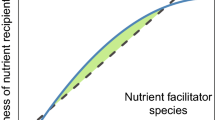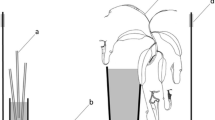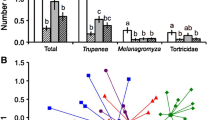Abstract
Positive species interactions are ubiquitous and crucial components of communities, but they are still not well incorporated into established ecological theories. The definitions of facilitation and mutualism overlap, and both are often context dependent. Many interactions that are facilitative under stressful conditions become competitive under more benign ones. This is known as the stress-gradient hypothesis, which is a specific case of context dependency. Stress can be further divided into resource and non-resource categories, but a better mechanistic understanding is necessary to improve the theory’s predictions. We examined if two pitcher-dwelling crab spiders (Thomisidae), Thomisus nepenthiphilus and Misumenops nepenthicola, can facilitate nitrogen sequestration in their pitcher plant host, Nepenthes gracilis, by ambushing pitcher-visiting flies and dropping their carcasses into pitchers after consumption. This relationship is, by definition, both mutualistic and facilitative. Laboratory experiments found that both crab spiders increased prey-capture rates of N. gracilis. Nutrient analyses showed that both crab spiders also decreased per unit nitrogen yield of prey. Using experiment duration as a proxy of prey-resource availability, we constructed a mechanistic conceptual model of nutritional benefit. The nutritional benefit received by N. gracilis from T. nepenthiphilus decreases with increasing levels of the limiting resource in the environment (i.e., decreasing levels of resource stress). Our findings suggest that any nutritional mutualism that increases the quantity of resource capture (e.g. number of prey individuals) but decreases the quality of the captured resource (e.g. nitrogen content of individual prey) will necessarily conform to the resource-based predictions of the stress gradient hypothesis.



Similar content being viewed by others
References
Adlassnig W, Peroutka M, Lendl T (2010) Traps of carnivorous pitcher plants as a habitat: composition of the fluid, biodiversity and mutualistic activities. Ann Bot 107:181–194
Anderson B, Midgley JJ (2003) Digestive mutualism, an alternate pathway in plant carnivory. Oikos 102:221–224
Armas C, Rodríguez-Echeverría S, Pugnaire FI (2011) A field test of the stress-gradient hypothesis along an aridity gradient. J Veg Sci 22:818–827
Bates D, Maechler M, Bolker B, Walker S (2015) Fitting linear mixed-effects models using lme4. J Stat Softw 67:1–48
Bauer U, Federle W, Seidel H et al (2015) How to catch more prey with less effective traps: explaining the evolution of temporarily inactive traps in carnivorous pitcher plants. Proc R Soc Lond [Biol] 282:20142675
Bazile V, Moran JA, Le Moguédec G et al (2012) A carnivorous plant fed by its ant symbiont: a unique multi-faceted nutritional mutualism. PLoS One 7:e36179
Beaver RA (1979) Biological studies of the fauna of pitcher plants (Nepenthes) in west Malaysia. Ann Soc Entomol Fr 15:3–17
Bertness MD, Callaway R (1994) Positive interactions in communities. Trends Ecol Evol 9:187–191. https://doi.org/10.1016/0169-5347(94)90087-6
Bonhomme V, Gounand I, Alaux C et al (2010) The plant-ant Camponotus schmitzi helps its carnivorous host-plant Nepenthes bicalcarata to catch its prey. J Trop Ecol 27:15–24. https://doi.org/10.1017/S0266467410000532
Bradshaw WE, Creelman RA (1984) Mutualism between the carnivorous purple pitcher plant and its inhabitants. Am Midl Nat 112:294–304
Bronstein JL (1994) Conditional outcomes in mutulistic interactions. Trends Ecol Evol 9:214–217
Bronstein JL (2009) The evolution of facilitation and mutualism. J Ecol 97:1160–1170. https://doi.org/10.1111/j.1365-2745.2009.01566.x
Bronstein JL (2015) The study of mutualism. In: Bronstein JL (ed) mutualism. Oxford University Press, Oxford, pp 3–19
Brooker RW, Callaway RM (2009) Facilitation in the conceptual melting pot. J Ecol 97:1117–1120. https://doi.org/10.1111/j.1365-2745.2009.01580.x
Brooker RW, Maestre FT, Callaway RM et al (2008) Facilitation in plant communities: the past, the present, and the future. J Ecol 96:18–34. https://doi.org/10.1111/j.1365-2745.2007.01295.x
Bruno JF, Stachowicz JJ, Bertness MD (2003) Incorporating facilitation into ecological theory. Trends Ecol Evol 18:119–125. https://doi.org/10.1016/S0169-5347(02)00045-9
Bulleri F, Bruno JF, Silliman BR, Stachowicz JJ (2016) Facilitation and the niche: implications for coexistence, range shifts and ecosystem functioning. Funct Ecol 30:70–78. https://doi.org/10.1111/1365-2435.12528
Burnham KP, Anderson DR (2002) Model selection and multimodel inference: a practical information-theoretic approach. Springer, New York
Butterfield BJ, Bradford JB, Armas C et al (2016) Does the stress-gradient hypothesis hold water? Disentangling spatial and temporal variation in plant effects on soil moisture in dryland systems. Funct Ecol 30:10–19. https://doi.org/10.1111/1365-2435.12592
Callaway RM, Nadkarni NM, Mahall BE (1991) Facilitation and interference of Quercus douglasii on understory productivity in Central California. Ecol Soc Am 72:1484–1499. https://doi.org/10.2307/1941122
Chamberlain SA, Bronstein JL, Rudgers JA (2014) How context dependent are species interactions? Ecol Lett 17:881–890. https://doi.org/10.1111/ele.12279
Chase JM, Leibold MA (2003) Ecological niches: linking classical and contemporary approaches. University of Chicago Press, Chicago
Choo JPS, Koh TL, Ng PKL (1997) Pitcher fluid macrofauna: nematodes and arthropods. In: Tan HTW (ed) A guide to the carnivorous plants of Singapore. Singapore Science Centre, Singapore, pp 51–96
Chua TJL, Lim MLM (2012) Cross-habitat predation in Nepenthes gracilis: the red crab spider Misumenops nepenthicola influences abundance of pitcher dipteran larvae. J Trop Ecol 28:97–104. https://doi.org/10.1017/S0266467411000629
Clarke CM (2001) Nepenthes of Sumatra and Peninsular Malaysia. Natural History Publications (Borneo), Kota Kinabalu
Clarke CM, Bauer U, Lee CC et al (2009) Tree shrew lavatories: a novel nitrogen sequestration strategy in a tropical pitcher plant. Biol Lett 5:632–635
De Mazancourt C, Schwartz MW (2010) A resource ratio theory of cooperation. Ecol Lett 13:349–359
Di Giusto B, Grosbois V, Fargeas E et al (2008) Contribution of pitcher fragrance and fluid viscosity to high prey diversity in a Nepenthes carnivorous plant from Borneo. J Biosci 33:121–136
Ellis AG, Midgley JJ (1996) A new plant–animal mutualism involving a plant with sticky leaves and a resident hemipteran insect. Oecologia 106:478–481. https://doi.org/10.1007/s00442-007
Fugère V, Andino P, Espinosa R et al (2012) Testing the stress-gradient hypothesis with aquatic detritivorous invertebrates: insights for biodiversity-ecosystem functioning research. J Anim Ecol 81:1259–1267. https://doi.org/10.1111/j.1365-2656.2012.01994.x
Gaume L, Bazile V, Bonhomme V (2016) Different pitcher shapes and trapping syndromes explain resource partitioning in Nepenthes species. Ecol Evol 6:1378–1392. https://doi.org/10.1002/ece3.1920
Hatano N, Hamada T (2008) Proteome analysis of pitcher fluid of the carnivorous plant Nepenthes alata. J Proteome Res 7:809–816
Holland JN, DeAngelis DL (2010) A consumer–resource approach to the density-dependent population dynamics of mutualism. Ecology 91:1286–1295. https://doi.org/10.1890/09-1163.1
Holmgren M, Scheffer M (2010) Strong facilitation in mild environments: the stress gradient hypothesis revisited. J Ecol 98:1269–1275. https://doi.org/10.1111/j.1365-2745.2010.01709.x
Holmgren M, Scheffer M, Huston MA (1997) The interplay of facilitation and competition in plant communities. Ecology 78:1966–1975. https://doi.org/10.2307/2265937
Lam WN, Chong KY, Anand GS, Tan HTW (2017) Dipteran larvae and microbes facilitate nutrient sequestration in the Nepenthes gracilis pitcher plant host. Biol Lett 13:20160928
Lam WN, Wang WY, Cheong LF et al (2018) Pitcher plant facilitates prey capture in a sympatric congener. Plant Ecol 219:299–311
Lenth RV (2016) Least-squares means: the R package lsmeans. J Stat Softw 69:1–33
Maestre FT, Callaway RM, Valladares F, Lortie CJ (2009) Refining the stress-gradient hypothesis for competition and facilitation in plant communities. J Ecol 87:199–205. https://doi.org/10.1111/j.1365-2745.2008.01476.x
Mazerolle MJ (2016) AICcmodavg: model selection and multimodel inference based on (Q)AIC(c). R package version 2.0-4. http://CRAN.R-project.org/package=AICcmodavg. Accessed 24 Feb 2017
Moran JA, Moran AJ (1998) Foliar reflectance and vector analysis reveal nutrient stress in prey-deprived pitcher plants (Nepenthes rafflesiana). Int J Plant Sci 159:996–1001
Moran J, Booth W, Charles J (1999) Aspects of pitcher morphology and spectral characteristics of six Bornean Nepenthes pitcher plant species: implications for prey capture. Ann Bot 83:521–528. https://doi.org/10.1006/anbo.1999.0857
Morse DH (1981) Prey capture by the crab spider Misumena vatia (Clerck) (Thomisidae) on three common native flowers. Am Midl Nat 105:358–367
O’Brien MJ, Pugnaire FI, Armas C et al (2017) The shift from plant–plant facilitation to competition under severe water deficit is spatially explicit. Ecol Evol 7:2441–2448
Pakeman RJ, Pugnaire FI, Michalet R et al (2009) Is the cask of facilitation ready for bottling? A symposium on the connectivity and future directions of positive plant interactions. Biol Lett 5:577–579. https://doi.org/10.1098/rsbl.2009.0384
Prieto I, Kikvidze Z, Pugnaire FI (2010) Hydraulic lift: soil processes and transpiration in the Mediterranean leguminous shrub Retama sphaerocarpa (L.) Boiss. Plant Soil 329:447–456
Rembold K, Fischer E, Striffler BF, Barthlott W (2012) Crab spider association with the Malagasy pitcher plant Nepenthes madagascariensis. Afr J Ecol 51:188–191. https://doi.org/10.1111/aje.12037
Romero GQ, Mazzafera P, Vasconcellos-Neto J, Trivelin PC (2006) Bromeliad-living spiders improve host plant nutrition and growth. Ecology 87:803–808
Ruppert EE, Fox RS, Barnes RD (2004) Invertebrate zoology: a functional evolutionary approach, 7th edn. Thomson, Brooks
Schöner CR, Schöner MG, Grafe TU et al (2017) Ecological outsourcing: a pitcher plant benefits from transferring pre-digestion of prey to a bat mutualist. J Ecol 105:400–411. https://doi.org/10.1111/1365-2745.12653
Schupp EW, Jordano P, Gómez JM (2017) A general framework for effectiveness concepts in mutualisms. Ecol Lett 20:577–590
Stachowicz JJ (2001) The structure of ecological communities. Bioscience 51:235–246. https://doi.org/10.1641/0006-3568(2001)051%5B0235:MFATSO%5D2.0.CO;2
Takahashi K, Athauda SBP, Matsumoto K et al (2005) Nepenthesin, a unique member of a novel subfamily of aspartic proteinases: enzymatic and structural characteristics. Curr Protein Pept Sci 6:513–525. https://doi.org/10.1042/BJ20031575
Thompson JN (1981) Reversed animal-plant interactions: the evolution of insectivorous and ant-fed plants. Biol J Linn Soc 16:147–155
Zuur AF, Ieno EN, Walker NJ, Saveliev AA, Smith GM (2009) GLM and GAM for absence–presence and proportional data. Mixed effects models and extensions in ecology with R. Springer, New York, pp 245–259
Acknowledgements
The authors are grateful towards Li Daiqin and Matthew L. M. Lim for constructive advice in study design, Tan Ming Kai for assistance with video recording, Goh Poi Moi for advice in starting and maintaining the fly culture and Liew Chye Fong, for assistance with spectrophotometry. We would also like to thank three anonymous reviewers, whose comments greatly improved the quality of the manuscript.
Author information
Authors and Affiliations
Contributions
WNL and HTWT formulated the original study design, WNL and RJYL developed the methodology, and RJYL conducted experiments and analysis. WNL wrote the manuscript, and all other authors provided editorial advice.
Corresponding author
Ethics declarations
Conflict of interest
The authors declare that they have no conflict of interest.
Additional information
Communicated by Paulo Guimaraes.
Electronic supplementary material
Below is the link to the electronic supplementary material.
Video S1 Thomisus nepenthiphilus ambushing a flesh fly on the pitcher lid, subsequently carrying its carcass into the pitcher interior (MPG 8938 kb)
Video S2
Thomisus nepenthiphilus ambushing a flesh fly under the peristome of a pitcher (MPG 262 kb)
Video S3 Misumenops nepenthicola ambushing a flesh fly under the peristome of a pitcher, dragging it down into the pitcher with it. (MPG 956 kb)
Video S4
Misumenops nepenthicola ambushing a flesh fly on the inner wall of a pitcher just as it lands; both fall into the pitcher together. (MPG 580 kb)
Rights and permissions
About this article
Cite this article
Lim, R.J.Y., Lam, W.N. & Tan, H.T.W. Novel pitcher plant–spider mutualism is dependent upon environmental resource abundance. Oecologia 188, 791–800 (2018). https://doi.org/10.1007/s00442-018-4246-8
Received:
Accepted:
Published:
Issue Date:
DOI: https://doi.org/10.1007/s00442-018-4246-8




